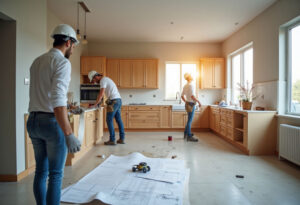Water is one of the most precious resources we have—and the bathroom is where much of it gets used (and often wasted). As environmental concerns and utility costs rise, homeowners are turning to water-efficient bathroom fixtures to create more sustainable, eco-friendly bathrooms without compromising comfort or style.
From low-flow toilets to smart faucets and aerated showerheads, today’s technology allows us to save thousands of gallons each year—often without even noticing a difference in performance. But with so many options on the market, how do you know what’s worth installing?
In this in-depth guide, you’ll learn how to build a water-conscious bathroom using efficient fixtures that not only reduce your environmental footprint but also slash your monthly water bills.
Here’s what we’ll cover:
- Key water-saving fixtures and how they work
- The environmental and financial impact of fixture upgrades
- Smart plumbing technology and automation
- Design ideas for eco-friendly, modern bathrooms
- Common myths about low-flow systems
- Practical tips for renovation or retrofitting
The Rise of Sustainable Bathroom Design
Designers are now embracing sustainability as a creative challenge—one that involves using innovative materials, intelligent plumbing, and elegant layouts. The result? Bathrooms that are lighter on the environment but still feel luxurious and indulgent. Whether you’re building from scratch or remodeling, the trend is clear: water-efficient design is no longer optional—it’s essential.
Stylish Water-Saving Fixtures That Don’t Sacrifice Looks
Gone are the days of clunky, industrial-looking “green” fixtures. Today’s water-efficient options are designed with both form and function in mind. Brands now produce aesthetic low-flow fixtures that rival their high-consumption counterparts in style and performance.
Here’s what’s trending:
- Slimline dual-flush toilets with concealed tanks or wall-mount options
- Sculptural faucets with aerators hidden within seamless designs
- Rainfall-inspired low-flow showerheads that create a full spa-like experience
- Touchless, motion-sensor faucets in matte black or brushed gold finishes
These fixtures don’t scream “eco”—they whisper it with subtle elegance.
Mixing Minimalism with Efficiency
Minimalist design naturally complements water efficiency. Clean lines, uncluttered surfaces, and multi-functional elements reduce waste while amplifying style. Think of a bathroom with just the essentials—each one smart, sustainable, and beautiful.
Design tips for minimal + efficient bathrooms:
- Use floating vanities and wall-mounted fixtures to reduce footprint
- Choose one large basin sink with a dual faucet instead of two separate vanities
- Opt for frameless glass showers to visually open up tight spaces
- Select low-flow mixer taps that provide immediate temperature balance
When every item in your bathroom has a purpose, your water consumption naturally drops.
Low-Flow Toilets with Modern Design Features
Toilets are the biggest water users in the bathroom—but also the easiest to upgrade. Modern low-flow and dual-flush toilets have evolved to match high-end aesthetics without compromising performance.
Here’s what to look for:
- Dual-flush systems that let you choose how much water to use per flush
- Wall-hung toilets for a sleek, floating appearance and easy floor cleaning
- Compact round-front models ideal for small bathrooms
- Skirted bases that hide plumbing and provide a cleaner silhouette
Pro Tip: Look for the WaterSense label, which guarantees EPA-certified performance and efficiency.
Sleek Showerheads That Use Less and Do More
Showers account for nearly 20% of household water use. Thankfully, the right low-flow showerhead can cut consumption in half—without sacrificing comfort. Some of today’s most elegant models are also the most efficient.
Features to consider:
- Air-infusion technology that maintains pressure while using less water
- Multi-spray settings for different moods (e.g., rainfall, massage, mist)
- Built-in filtration systems that purify water while you shower
- Eco-timers to encourage shorter, energy-saving showers
Design-wise, look for finishes that match your overall bathroom style—brushed nickel, matte black, polished brass—all available in eco-friendly options.
Matte Black, Brass & Chrome: Eco Looks Great in Every Finish
Sustainability doesn’t mean compromising on style. One of the biggest trends in water-efficient fixture design is the rise of premium finishes that pair beauty with environmental consciousness. Whether your bathroom is bold and modern or warm and rustic, there’s an eco-conscious fixture in a finish to match.
Popular finishes in eco-friendly fixtures:
- Matte Black: Clean, contemporary, and dramatic. Ideal for minimal or industrial themes.
- Brushed Brass: Soft, golden tones that add warmth and elegance to eco bathrooms.
- Polished Chrome: A timeless choice that reflects light beautifully and works with any style.
- Brushed Nickel: Understated and sleek—a favorite for spa-inspired designs.
These finishes are now available in WaterSense-labeled faucets, showerheads, and accessories, so you can build a cohesive look without wasting water.
Floating Vanities, Wall-Mounted Faucets & Drain Tricks
Water-efficient design extends beyond the fixture itself. Smart installations and layout choices can also improve drainage, minimize splashing, and enhance flow—all while contributing to an upscale aesthetic.
Consider these eco-smart design strategies:
- Floating vanities improve airflow and make floors easier to clean, reducing mold and mildew buildup.
- Wall-mounted faucets allow better control over water flow and often pair with smaller sinks, reducing water volume.
- Channel or slot drains are stylish and highly efficient, especially in walk-in wet rooms.
- Use angled sinks and splash-resistant basins to reduce mess and water waste.
Pro Tip: Each of these small design decisions contributes to a smarter, more efficient bathroom.
Water-Efficient Bathtubs and Wet Rooms
While showers are more efficient than baths by default, that doesn’t mean bathtubs are off the table for eco-conscious homeowners. The key lies in choosing better bathtubs—ones designed for efficiency and comfort.
Efficient bathtub options include:
- Deep soaking tubs that require less surface area and water than standard long tubs
- Freestanding slipper tubs with sloped backs that reduce the amount of fill needed
- Compact Japanese-style tubs for deep immersion in a small footprint
- Dual-purpose tub-shower combos with water-saving fixtures
Or consider a wet room design—a fully waterproofed bathroom with an open shower layout that promotes efficient drainage and faster cleaning, reducing product and water waste.
Eco-Friendly Tile and Materials to Pair with Fixtures
A sustainable bathroom isn’t just about water—it’s about materials too. Pairing your efficient fixtures with earth-conscious materials enhances your space both visually and ethically.
Top eco-friendly materials for modern bathrooms:
- Recycled glass tiles – Eye-catching, durable, and low-impact
- Porcelain tiles – Long-lasting, non-toxic, and widely recyclable
- Bamboo vanities – Fast-growing and sustainably harvested
- Concrete sinks or countertops – Chic, low-waste, and incredibly durable
- Low-VOC paints and sealants – Improve air quality while protecting surfaces
Bonus: Using sustainable materials often reduces the need for replacement and maintenance, saving money over time.
Smart Mirrors and Touchless Controls
High-tech meets sustainability with the latest smart bathroom innovations. These products may seem like luxury upgrades, but they’re also brilliant tools for reducing waste and improving hygiene.
Eco-forward tech features:
- Touchless faucets reduce water use by up to 70% compared to traditional handles
- Smart mirrors display time, temperature, and water usage tracking
- LED backlighting in mirrors and vanities uses less power and lasts longer
- Timed shut-off systems on showers and sinks encourage shorter usage
- Voice-activated controls integrate with home assistants for hands-free efficiency
These additions are especially powerful in family bathrooms, where accidental waste and long showers can be frequent.
Biophilic Design: Nature Meets Water-Saving
Biophilic design is the art of bringing the outdoors in—connecting interior spaces with nature to boost mood, wellness, and yes, sustainability. When paired with water-efficient fixtures, this design philosophy creates bathrooms that feel like tranquil retreats.
How to incorporate biophilic elements:
- Add humidity-loving plants near showers and tubs (e.g., ferns, pothos, snake plants)
- Use natural textures like stone, bamboo, and reclaimed wood
- Maximize natural light with frosted windows or skylights
- Choose color palettes inspired by earth tones and greenery
- Include open shelving for organic textiles like cotton towels or linen curtains
The more connected you feel to the natural world, the easier it becomes to adopt water-saving habits as a lifestyle—not just a renovation feature.
Small Space Sustainability: Half Baths Done Right
Small bathrooms and powder rooms might not seem like priority areas for water efficiency, but they’re actually some of the easiest places to make a big impact.
Smart upgrades for compact spaces:
- Install compact, wall-mounted toilets that use just 1.28 GPF or less
- Use narrow basin sinks with built-in aerators
- Add a motion-sensor faucet to eliminate wasted water during hand washing
- Incorporate a greywater system if possible—for example, connecting sink water to flush the toilet
Even in spaces under 50 square feet, sustainable design is completely achievable with thoughtful fixture selection.
Case Study: A Chic, Sustainable Bathroom Renovation
Let’s take a look at a real-world example to tie it all together.
Location: Urban townhouse in Vancouver, BC
Challenge: Outdated 90s-style bathroom with high-flow fixtures and minimal storage
Goals: Modernize aesthetics, reduce water usage, and maximize functionality in a small footprint
Key upgrades:
- Replaced a bulky bathtub with a curbless walk-in shower using a 1.5 GPM rain-style head
- Installed a wall-mounted dual-flush toilet (0.8 and 1.28 GPF options)
- Swapped outdated sink with a slim, matte black faucet featuring a built-in aerator
- Added motion-sensor LED mirror and bamboo vanity
- Finished with recycled glass mosaic tile and stone-look porcelain flooring
Results:
The homeowners reported a 35% drop in monthly water bills, a faster morning routine, and a space they now describe as “peaceful, modern, and guilt-free.”
The Perfect Blend: Efficiency, Design, and Function
Sustainability isn’t a style—it’s a system. When you blend water-efficient fixtures with modern materials, thoughtful layouts, and a touch of personal taste, you create a bathroom that not only looks great but lives well for years to come.
Quick checklist for a stylish, sustainable bathroom:
- Low-flow toilet with a clean, modern profile
- Water-saving showerhead that fits your aesthetic
- Aerated, touchless, or smart faucet
- Floating or bamboo vanity with low-VOC finishes
- Eco-conscious tile and surface materials
- Layered lighting with LED or motion sensors
- Natural accents: greenery, stone, reclaimed wood
When done right, sustainability enhances design—it doesn’t restrict it.
Final Thoughts
The future of bathroom renovation is sustainable, stylish, and smart. By choosing water-efficient fixtures that match your design vision, you’re not just reducing waste—you’re building a space that feels better, works harder, and reflects your values.
Whether you’re starting from scratch or making small upgrades, remember: every drop counts—and with the right fixture, you’ll never have to compromise beauty for performance.
Frequently Asked Questions
Do water-efficient fixtures really save that much water?
Yes. Replacing older toilets, faucets, and showerheads with water-efficient models can save up to 20,000 gallons per year in a single household—without noticeable performance differences.
Are water-saving showerheads less powerful?
Not anymore. Modern low-flow showerheads use air infusion or pressure-balancing tech to maintain strong spray patterns with lower GPM rates.
Will I notice a difference using a dual-flush toilet?
You’ll notice the difference in your water bill—not your experience. Dual-flush toilets offer options for full or partial flushes, reducing waste intelligently.
Can I get water-efficient fixtures in high-end finishes?
Absolutely. Brands now offer WaterSense-certified fixtures in matte black, brushed brass, chrome, nickel, and more—so you can go green without losing style.
Is it worth retrofitting a small powder room with water-saving fixtures?
Yes. Small bathrooms may use less water, but they’re often used frequently. Even one compact, low-flow faucet or toilet can make a big difference over time.





